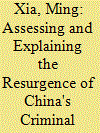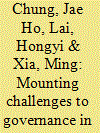| Srl | Item |
| 1 |
ID:
075701


|
|
|
|
|
| Publication |
2006.
|
| Summary/Abstract |
Based upon collected crime statistics, this paper provides a sketch of China's criminal underworld during the past two decades and a quantitative assessment of its current state. Through examining the organised criminal groups, it also assesses the hardcore of China's criminal underworld — the mafia-style criminal syndicates and their greater base — the underworld society. It argues that a challenge from the criminal underworld has increasingly posed a serious threat to Chinese society. It also provides explanations for the recent resurgence of the criminal underworld in China through a perspective of political science — placing emphasis on the state-failure factors.
|
|
|
|
|
|
|
|
|
|
|
|
|
|
|
|
| 2 |
ID:
073379


|
|
|
|
|
| Publication |
2006.
|
| Summary/Abstract |
With the further intensification of transitional reforms, the level of social instability in China has been rising unabated since the 1990s, calling overall governance into serious question. This study surveys three dimensions of instability in China - "collective public security incidents" (CoPSI), "unofficial" religious groups, and the expanding criminal networks - and explores the patterns of their regional distribution and the possibility of interconnectedness among the three. This study finds that both urban and rural protests have increased in frequency, expanded in size, diversified in terms of their participants' backgrounds, enlarged in geographical coverage, lasted longer and displayed higher levels of violence. The research also finds that economically stagnant central provinces of Henan, Hubei, Hunan and Sichuan are particularly vulnerable to instability. Furthermore, collective protests are gradually forming lateral linkages among different localities, religious sects and criminal organizations. Granted that discontents alone would not alter the political landscape, they can still serve as a strong catalyst to prod the Chinese state to search for effective solutions. While the state is not in an imminent danger of collapse, continuing instability is more likely than otherwise.
|
|
|
|
|
|
|
|
|
|
|
|
|
|
|
|
| 3 |
ID:
080716


|
|
|
|
|
| Publication |
2008.
|
| Summary/Abstract |
Chinese lawmakers and law-enforcers have viewed the hierarchical structure as the defining feature of organized criminal organizations. Such a flawed framework has hampered China's recent efforts to fight organized crime. Based upon organization theory, this paper argues that by adapting to the changing institutional environment, Chinese criminal forces have chosen a variety of organizational structures ranging from hierarchy to the market and the network. The recently uncovered cases point out that networks have become a more popular organizational form than the traditional hierarchies (such as secret societies) and contractual relationships in illicit markets. By offering a classification of organizational formations of organized crime in today's China, the author suggests network analysis as a new tool to help China's law enforcement effectively respond to surging organized crime.
|
|
|
|
|
|
|
|
|
|
|
|
|
|
|
|